Travelin’ Man: Las Vegas – part two

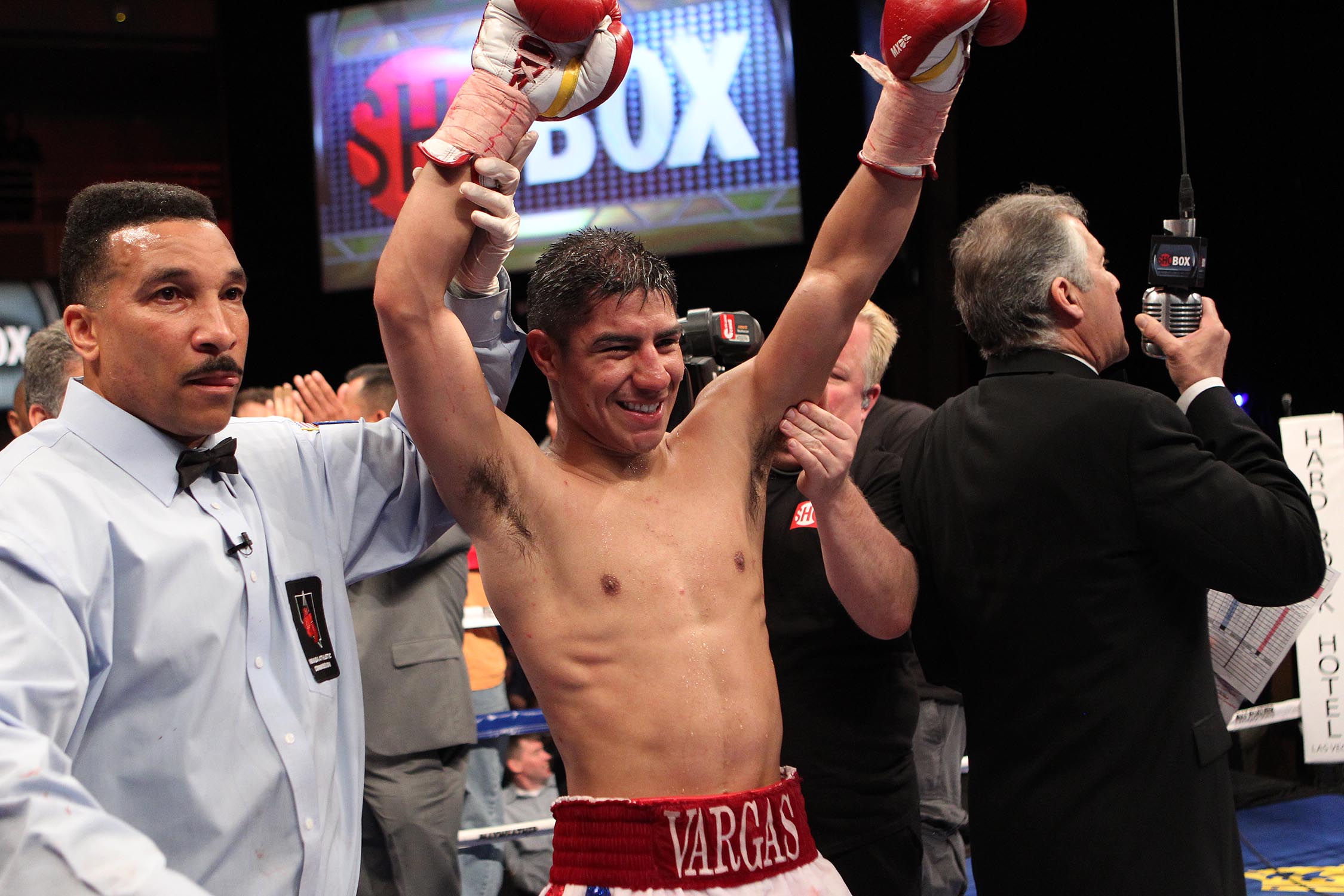
I arrived at the arena – called The Joint – a little after 12:30 and the set-up process was brief and uneventful, two of our favorite words. The crew meal was held at Mr. Lucky, a restaurant with diner-like fare. Punch-counting partner Andy Kasprzak and I ordered a club sandwich with fries, which I finished with surprising dispatch given my usual sloth-like pace. I then returned to ringside to ensure that all was well electronically until the show began at 6:30.
The first of the night’s five fights was a scheduled four-rounder pitting Los Angeles junior welterweights Joaquin Chavez (1-0-1, 1 KOs coming in) and Jalani Wilson, who was making his pro debut. While Chavez’s ring walk was largely business-like, Wilson’s was anything but. Wearing a red and black bandana over his mouth and an old-school high-top fade on his head, Wilson rolled into the ring and then executed a perfect kip-up to his feet. As ring announcer Jake Gutierrez introduced them, Wilson sat on his haunches and stared bullets at his adversary a la Aaron Pryor.
Wilson wore a confident sneer and floated about the ring to convey his sense of superiority. At times he pirouetted his way back into position after missing with a wild shot over the top, but he appeared to win the opening round with relative ease. Chavez ignored Wilson’s preening in round two but lost the third when Wilson regained his rhythm. The fourth was close and difficult to score. In the end Wilson held a narrow 59-53 lead in total connects and the judges agreed on the bout’s closeness as they scored it a rare three-way draw (38-38). The action was often wild and ungainly, not surprising given each man’s professional inexperience. But for what it was, it was a good watch.
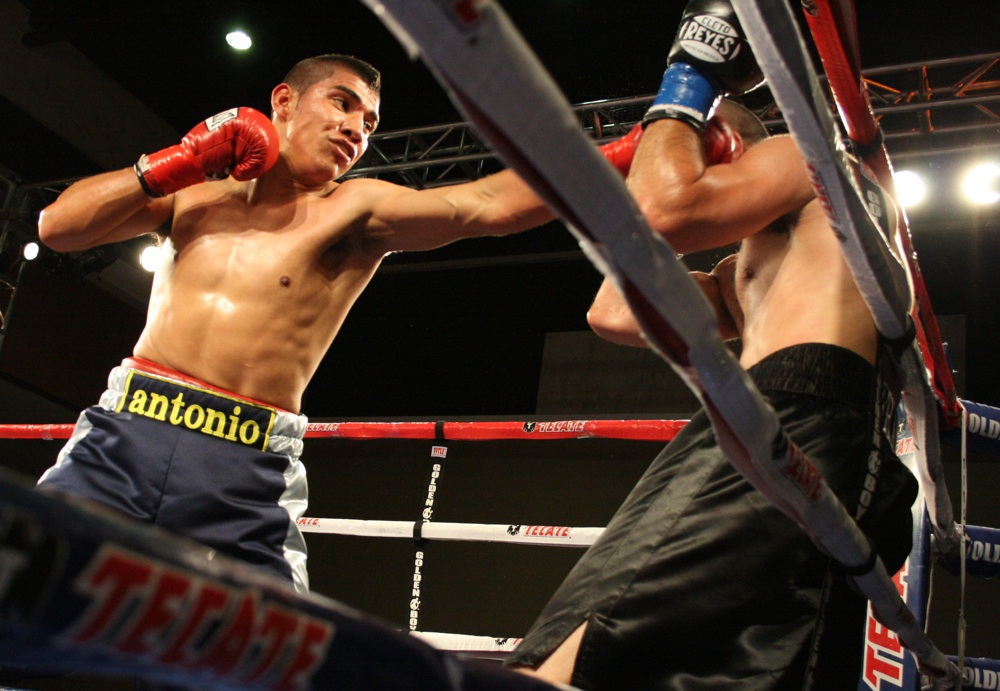 The night’s most impressive performance in terms of technique and execution belonged to San Diego’s Antonio Orozco (12-0, 8 KOs coming in), who disposed of Los Mochis’ Rodolfo Armenta (11-5-1, 9 KOs coming in) in round four. From first second to last, Orozco was every inch the fistic specimen. Advancing from a crouched stance, Orozco uncoiled crisp, compact combinations that easily shifted from body to head and connected like thunderclaps. More than once he snapped off Tyson-esque right-to-the-body, right-uppercut-to-the-jaw salvos and one had to be impressed with Armenta’s durability under the assault. In round two alone Orozco went 47 of 110, including 42 of 72 power shots while Armenta managed to go 13 of 46 and 10 of 26 respectively.
The night’s most impressive performance in terms of technique and execution belonged to San Diego’s Antonio Orozco (12-0, 8 KOs coming in), who disposed of Los Mochis’ Rodolfo Armenta (11-5-1, 9 KOs coming in) in round four. From first second to last, Orozco was every inch the fistic specimen. Advancing from a crouched stance, Orozco uncoiled crisp, compact combinations that easily shifted from body to head and connected like thunderclaps. More than once he snapped off Tyson-esque right-to-the-body, right-uppercut-to-the-jaw salvos and one had to be impressed with Armenta’s durability under the assault. In round two alone Orozco went 47 of 110, including 42 of 72 power shots while Armenta managed to go 13 of 46 and 10 of 26 respectively.
The most captivating part of Orozco’s performance was the way he ended it. An accidental butt early in the fourth opened a nasty gash over Armenta’s left eye and a cut atop Orozco’s head. After the ringside physician examined both men, Orozco’s attitude shifted from aggressive technician to remorseless executioner. As if to say “enough of this,” Orozco maneuvered Armenta toward the ropes and belted a good-night hook that left his rival sprawled on the canvas. Although Armenta bravely regained his feet he couldn’t adequately respond to referee Kenny Bayless’ commands and the fight ended at the 1:09 mark.
No wonder: Orozco out-landed Armenta 124-28 overall and 113-19 in power shots, landing 42 percent of his 293 total punches to Armenta’s 22 percent of 198. Worse yet for the Mexican was that Orozco landed 57 percent of his hooks, crosses and uppercuts and led 70-5 in connected body shots.
The final pre-TV match was explosive to say the least. Featherweights Rocco Espinoza of Las Vegas and David Clark of San Diego each sported 3-2 records but given that onetime WBC super featherweight champion Cornelius Boza-Edwards was in Espinoza’s corner one had reason to believe he was playing the role of prospect. For the first minute of the fight he looked the part as his blows quickly reddened Clark’s face. Unfortunately for Espinoza, none of his victories were by knockout while all of Clark’s were. Clark showed why with startling suddenness; an out-of-nowhere counter right crumpled Espinoza at the round’s midway mark while a second counter cross took out his legs moments later. Clark quickly put Espinoza out of his misery with a final volley 123 seconds after the opening bell.
The co-feature pitting Deandre Latimore (22-3, 17 KOs coming in) of Las Vegas by way of St. Louis and Colombian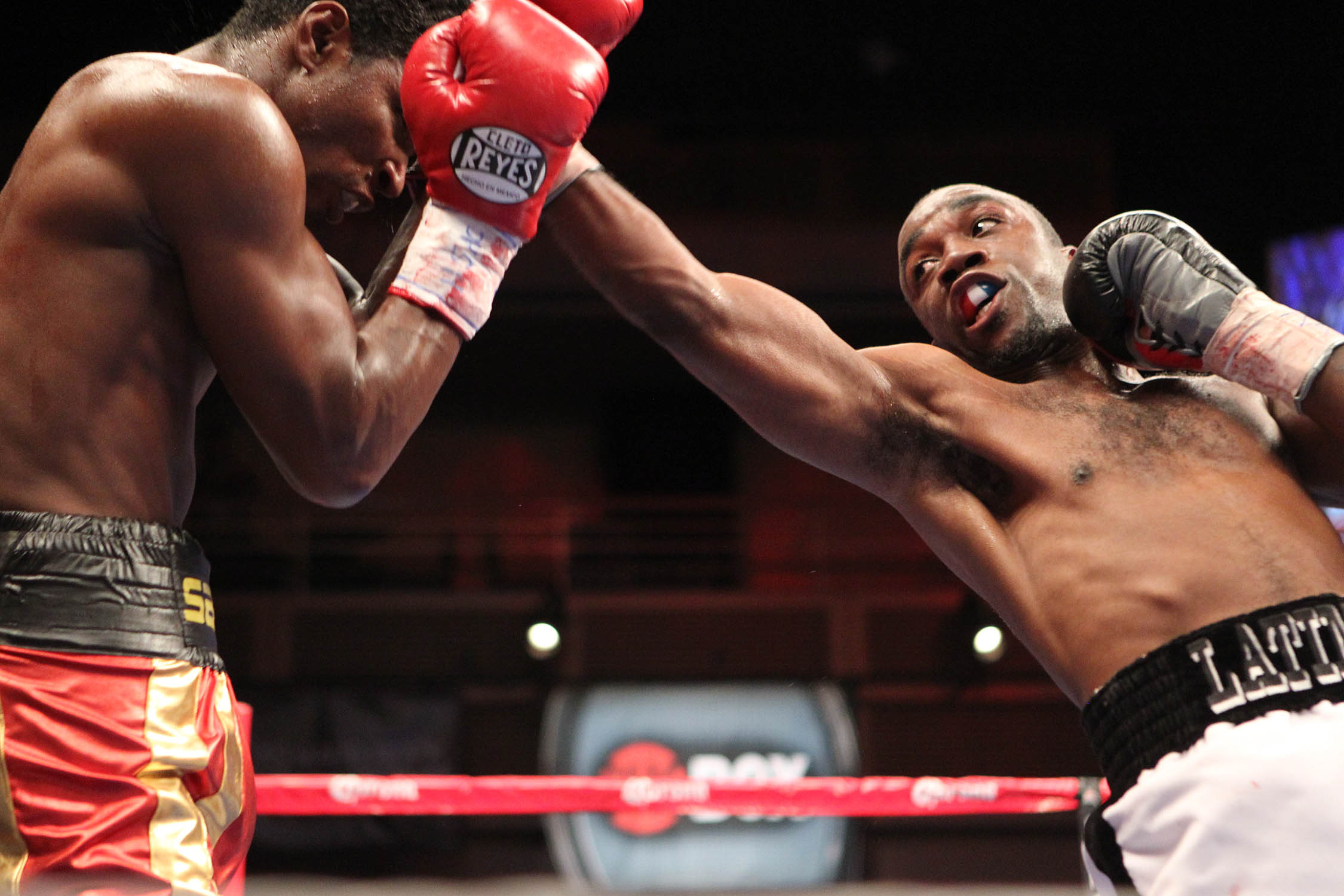 power-hitter Milton Nunez (23-3-1, 21 KOs coming in) appeared competitive numerically but mismatched circumstantially. After all, the willowy Nunez was summoned on less than three days’ notice after Ryan Davis had failed his medicals and all three losses had come by first-round KO. Even worse was the fact that Nunez was bone-dry before the first bell.
power-hitter Milton Nunez (23-3-1, 21 KOs coming in) appeared competitive numerically but mismatched circumstantially. After all, the willowy Nunez was summoned on less than three days’ notice after Ryan Davis had failed his medicals and all three losses had come by first-round KO. Even worse was the fact that Nunez was bone-dry before the first bell.
Yes, Latimore was coming off a 10-month layoff and a 2-3 stretch in his last five, but he not only had beaten a better grade of opposition he also sported the left-handed advantage. But once the opening bell sounded the fighters proceeded to prove yet again that no matter how well-grounded the argument there is always a way for the unexpected to spring its trap.
Under the tutelage of new trainer Jeff Mayweather, Latimore sought to box instead of slug and many times he appeared to be thinking out his tactics instead of reacting naturally. The tepid pace worked in Latimore’s favor and over the first eight rounds he built connect leads of 98-73 (overall) and 71-49 (power). Despite a dominant 30-11 total connect bulge in the seventh, Latimore chose to throttle down in the eighth and ninth, perhaps to get in more practice on his new techniques.
There’s always something dangerous about Colombian sluggers and that axiom came true in the final minute of the 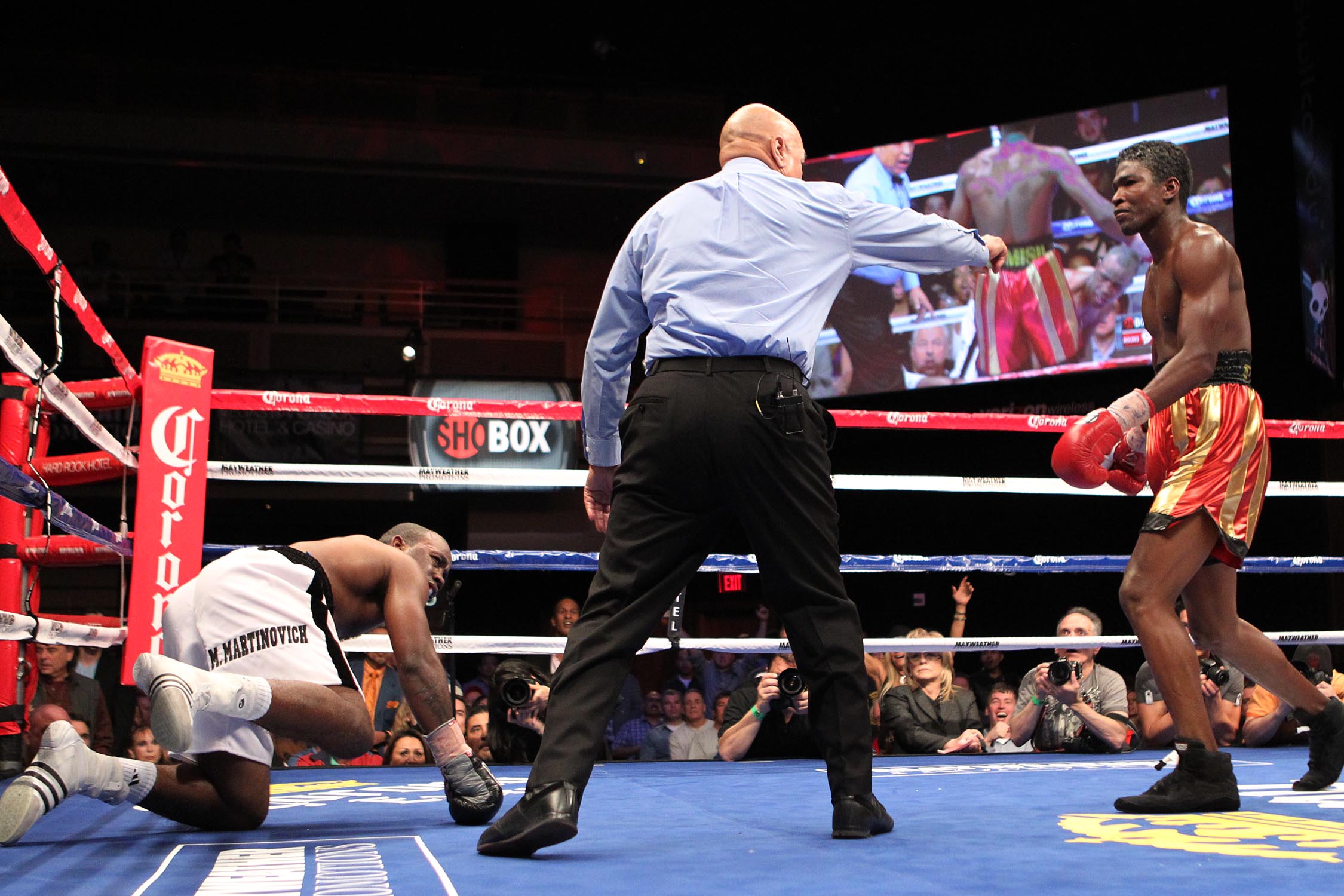 ninth after Nunez dramatically wobbled Latimore and floored him – at least officially – in the round’s final second. The scoring gap closed even more in the 10th when a butt thought to be a right hand decked Latimore with less than a half-minute remaining in the fight. Latimore survived the round, then the judges’ scorecards as he escaped with a 96-92, 95-94, 94-94 majority nod.
ninth after Nunez dramatically wobbled Latimore and floored him – at least officially – in the round’s final second. The scoring gap closed even more in the 10th when a butt thought to be a right hand decked Latimore with less than a half-minute remaining in the fight. Latimore survived the round, then the judges’ scorecards as he escaped with a 96-92, 95-94, 94-94 majority nod.
The stats reflected the bout’s closeness – but also explained Latimore’s victory. Latimore led 108-98 in total connects, out-jabbed his taller opponent 34-28 despite throwing 60 fewer (208-268) and retained a 74-70 edge in power connects while landing at a far higher rate (50 percent to 32 percent). Nunez made the fight close courtesy of the 25-10 (overall) and 21-3 (power) connect advantages he produced in the final two rounds.
The main event between prospect Jessie Vargas (17-0, 9 KOs coming in) and veteran Lanardo Tyner (25-6-2, 15 KO coming in) was a challenging yet necessary step in Vargas’ ring maturity. The 36-year-old Tyner might have gone 1-3-1 in his last five but in his mind and heart he was no one’s stepping-stone. He fought with bristling defiance, winging huge punches despite absorbing a vicious body battering – both legal and illegal. Vargas landed cringe-inducing low blows in rounds one and four while a roiling Tyner answered the first foul with one of his own earlier in the fourth.
Vargas, bent on vengeance and nearing disqualification in the fourth, was at a mental crossroads. He could have 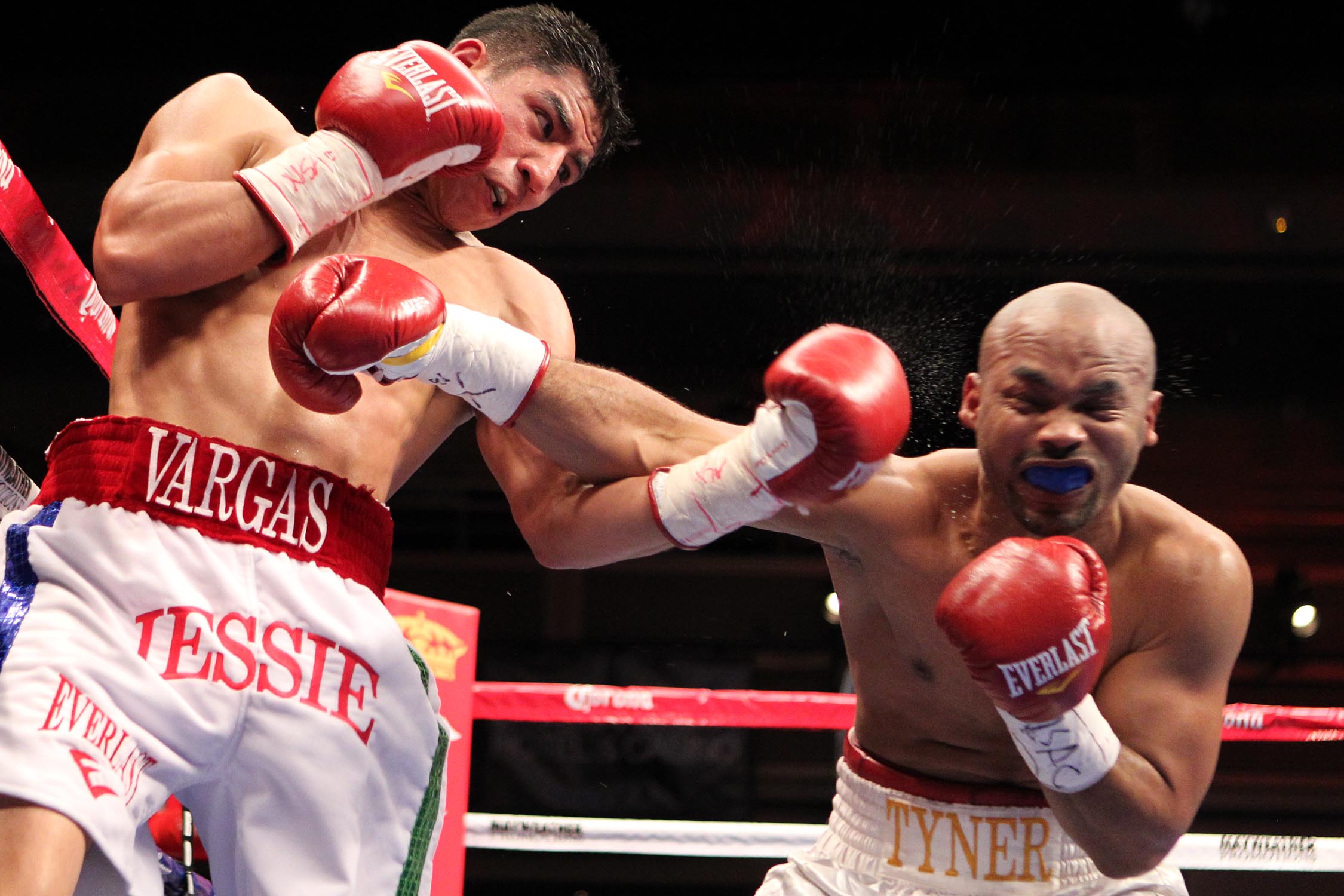 acted further on his emotions but instead he settled behind his jab in the sixth and seventh and banged heavy shots at close range along the ropes to dominate the ninth. Yes, there was another rough patch by both men in the eighth as Vargas was warned for another low shot and a subsequent encounter saw Tyner tumble outside the ring, but for long stretches Vargas seemed to put business ahead of bull.
acted further on his emotions but instead he settled behind his jab in the sixth and seventh and banged heavy shots at close range along the ropes to dominate the ninth. Yes, there was another rough patch by both men in the eighth as Vargas was warned for another low shot and a subsequent encounter saw Tyner tumble outside the ring, but for long stretches Vargas seemed to put business ahead of bull.
All three judges turned in 99-91 scorecards and the CompuBox stats reflected that dominance. Vargas led in all three categories in terms of connects – 225-155 total, 59-24 jabs and 166-131 power – and was the far more accurate striker as he enjoyed percentage edges of 40-33 overall and 47-34 power. Each connected on 28 percent of their jabs. Vargas out-landed Tyner nine out of 10 rounds, with a 15-15 tie in the eighth interrupting the string.
All went well at ringside as the process of passing notes to the talent and communicating suggestions to the truck went off with little trouble. After briefly talking with ringsiders and the folks inside the production truck, Andy and I relaxed over a few beverages inside the casino before we went our separate ways. I spent the next several hours tapping away on the laptop and by the time I finished I realized there was less than four hours before my intended rising time. I had a decision to make: Try to get in some rest or stay up and try to sleep on the four-hour Las Vegas to Charlotte leg.
Saturday, February 25:I ended up doing what I did last week in Santa Ynez – rested my eyes while keeping an eye on the clock. The goal was to be alert enough to carry out what needed to be done and shut down the rest of the time. With any luck I would have recharged my batteries enough to complete the long drive home to West Virginia.
If there were any doubts about whether zombies exist, just visit an airport at 5:30 a.m. There were plenty, and I felt like one of them. My usually brisk stride was reduced to a sluggish shuffle and puffs of fatigue clouded my consciousness. For me, the trick was to stay awake enough to hear the signal to board over the loudspeaker but remain sleepy enough to fall into semi-conscious slumber once I found my seat.
The head wind that worked so much against us on Thursday turned into a powerful tail wind this day, shortening the expected four-hour flight by nearly an hour. This limited the shuteye I was able to get, along with both of my seatmates jostling me awake because they needed to use the facilities.
Adding to the angst was a longer than expected wait at the gate in Charlotte. The flight crew for the Pittsburgh leg was in transit from Baltimore and their plane landed behind schedule. Then, after the boarding process had already begun, a mechanical issue was discovered. I was afraid I was going to fall asleep at the gate, but thankfully the issue was resolved in quick order and I was able to board 40 minutes later than expected.
I caught a few more winks on the flight but midway through my eyes snapped open and suddenly I was fully alert. Somehow, all the near-beer napping had worked its magic and I had more than enough energy to safely drive home. Yet once I stopped in the driveway, the weariness returned in spades. The need to perform was no longer there and at the moment there was nothing more I wanted to do than to crawl into bed and hibernate.
I did stay awake long enough to coordinate my Saturday night boxing recordings and I even watched the HBO doubleheader that saw Adrien Broner impressively dispose of Eloy Perez and Devon Alexander whitewash Marcos Maidana. It was “Alexander the Great’s” best performance since his one-punch knockout of Juan Urango several years ago and it lent credence to his claim that weight issues were to blame for his sub-par performances. At 147 his physique looked tight and muscular while Maidana’s build and usual volume-punching pressure attack were on the soft side.
Shortly after midnight the long, long day finally came to an end and for the next nine-plus hours this office was closed to everyone and everything.
The next assignment for this Travelin’ Man will take place March 22-24 when I’ll be ringside for a ShoBox telecast in Tucson. Until then, happy trails.
Photos of Vargas and Latimore by Tom Casino-SHOWTIME
Photo of Orozco by RoundOne Media
Photo of Las Veags sign from iStockphotos.com/Rpsycho
Lee Groves can be e-mailed at [email protected]. Groves is a boxing writer and historian based in Friendly, West Virginia. He is a full member of the BWAA, from which he has won five writing awards, and an elector for the International Boxing Hall of Fame. He is also a writer, researcher and punch-counter for CompuBox, Inc and the author of “Tales from the Vault: A Celebration of 100 Boxing Closet Classics.” To order, please visit Amazon.com or e-mail the author to arrange for autographed copies.















